Monday, 21 August, Greenville, SC: The Eclipse!
Written 23 October 2017
Of all the good choices and advance plans Jay made for the weekend, the best was to view the eclipse from the Roper Mountain Science Center. The RMSC is a little like the Tallahassee Museum of History and Natural Science, in that it has a small reconstructed farm made up of relocated buildings, with live farm animals and a demonstration garden; a natural history building with nature exhibits and live reptiles; nature trails; and a butterfly garden, but it is on a grander scale, incorporating in addition, an observatory, a planetarium, a butterfly house, and a conference center.
It was so close to our hotel that we could easily have walked there if we hadn't been planning to take about half a ton of gear with us (chairs, blankets, coolers, water bottles, soft drinks, binoculars, materials for pinhole cameras, a colander for multiple pinhole effects, etc.).
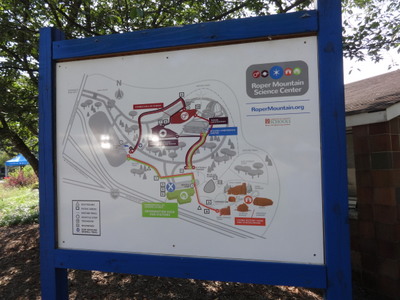
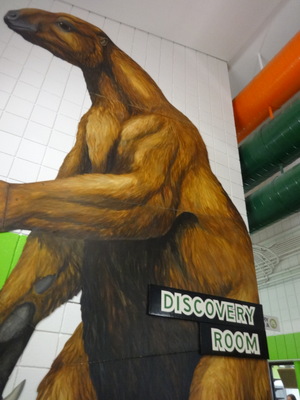 For the occasion of the eclipse, they sold exactly 500 tickets (sold out weeks in advance). The ticket packets included maps, instructions, and NASA-approved viewing glasses. The gates opened at 9 a.m. and closed again at 10:30 a.m., enclosing our party of 14 (Jay and Pam's daughter, her husband, and their three sons joined us) and the other 486 ticket holders, an assortment of food trucks, the park staff, and several professional astronomers recruited for the event. Maps had been prepared indicating the four "viewing areas" preselected by the staff and listing what was allowed at which of them (some allowed tents and chairs, others picknicking but no furniture, and others standing room only). We chose the most permissive area, in front of the Harrison Hall of Natural Science, a little northeast of the blue-circled "X" on the map.
For the occasion of the eclipse, they sold exactly 500 tickets (sold out weeks in advance). The ticket packets included maps, instructions, and NASA-approved viewing glasses. The gates opened at 9 a.m. and closed again at 10:30 a.m., enclosing our party of 14 (Jay and Pam's daughter, her husband, and their three sons joined us) and the other 486 ticket holders, an assortment of food trucks, the park staff, and several professional astronomers recruited for the event. Maps had been prepared indicating the four "viewing areas" preselected by the staff and listing what was allowed at which of them (some allowed tents and chairs, others picknicking but no furniture, and others standing room only). We chose the most permissive area, in front of the Harrison Hall of Natural Science, a little northeast of the blue-circled "X" on the map.
While those of us who were into such things went into the Hall of Science to see the butterflies, pet the reptiles (well, one of them anyway; a young volunteer was holding a ball python for the purpose, while the other reptiles were protected behind glass), and enjoy some air conditioning, Ev volunteered to hike up to the planetarium to buy tickets for the eclipse show at 11:30 a.m.
On a wall inside the Hall of Science was this painting of a giant ground sloth, life size. I think that's a 12-foot ceiling.
The day was beautifully clear, just right for viewing an eclipse, but it was therefore, of course, blazing hot as well. We were glad to have doused ourselves with sunscreen before coming out.
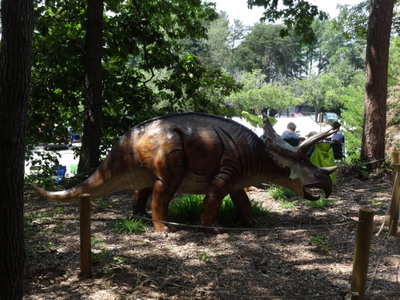
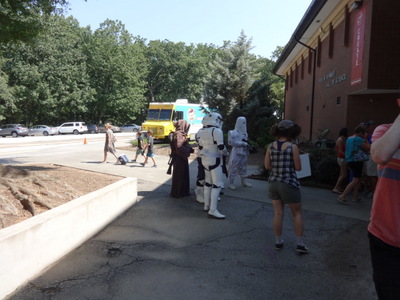 On our way up the hill to the planetarium for the eclipse show, we passed this in the woods, also life size.
On our way up the hill to the planetarium for the eclipse show, we passed this in the woods, also life size.
Outside the Fred W. Symmes Hall of Science, we encountered this group of storm troopers and one of those creatures with the brown robes and hoods and red eyes, so I assume the exhibit inside had to do with Star Wars, but we didn't take time to explore it. The planetarium show was good; I learned there for the first time that during the 2.5 minutes of totality of a total eclipse, you can safely take off your dark glasses and look directly at it! During my last eclipse, we were told never, never, never to look directly at it. Perhaps that was only an annual eclipse, as I distinctly remember seeing solar flares in my pinhole camera, whereas we couldn't this time.
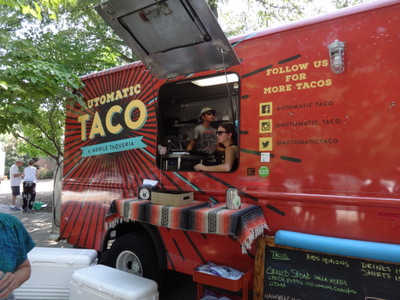
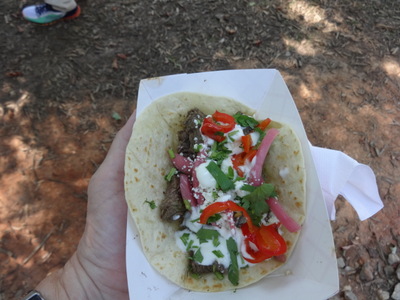 After the show, we scattered in search of the food trucks of our choice. David and I chose Automatic Taco and ordered grilled steak with salsa verde, cheese, pickled red onion, and cilantro crema. Yum!
After the show, we scattered in search of the food trucks of our choice. David and I chose Automatic Taco and ordered grilled steak with salsa verde, cheese, pickled red onion, and cilantro crema. Yum!
Then it was time to reassemble at the "campsite" for the main event! Sure enough, at 1:26 p.m., the first nibble appeared out of the upper right quadrant of the sun. The astronomer assigned to our viewing area narrated over the loudspeakers, and a guy who had set up near us let little kids look through his huge and elaborate telescope (equipped of course with heavy-duty filters).
A little girl nearby complained that it didn't seem real. Without her dark glasses, she could see the whole world but not the eclipse, but the glasses were so dark that, when them on, she could see the eclipse but nothing else; it might as well have been a cartoon.
What astonished everyone around us was that it didn't get dark! The light seemed as strong as on an ordinary cloudy day even when only a tiny fraction of the sun's disk remained exposed, and we didn't feel a decrease in the heat until quite late in the process. Then that last tiny fraction of the sun disappeared, and suddenly night fell. It wasn't totally dark—more like a moonlit night—but the transition was very abrupt. A bird that happened to be in flight over us panicked, finding itself suddenly in mid air and unable to see (diurnal birds have very poor night vision); it fluttered in tight circles and zigzags for a minute, so erratically that I thought for a moment it was a bat. Then it spotted a street light that had come on in the nearby parking lot and made for that, where it was able to find a branch to perch on.
For a couple of minutes, we were able to take off our glasses, and the little girl was right—it all seemed much more real when you could see the world and the eclipsed sun at the same time! Jay got some spectacular photos of the moment of totality. I tried, but my camera wasn't up to the task; I just got a bright spot in the sky (with nearby star). Then it was time to put the glasses back on. Sure enough, when that first sunbeam peeked out from behind the moon, the world lit up again, just as abruptly.
We stayed around for a while, to let rush go by, then made our way back to the main parking lot, lugging all our stuff. We dispersed to our various houses and hotel rooms to clean up and cool off for a little while before reconvening at Jay and Pam's place for a dinner of home-made pulled pork barbecue. A highly successful eclipse day!
Previous entry
List of Entries
Next entry

 For the occasion of the eclipse, they sold exactly 500 tickets (sold out weeks in advance). The ticket packets included maps, instructions, and NASA-approved viewing glasses. The gates opened at 9 a.m. and closed again at 10:30 a.m., enclosing our party of 14 (Jay and Pam's daughter, her husband, and their three sons joined us) and the other 486 ticket holders, an assortment of food trucks, the park staff, and several professional astronomers recruited for the event. Maps had been prepared indicating the four "viewing areas" preselected by the staff and listing what was allowed at which of them (some allowed tents and chairs, others picknicking but no furniture, and others standing room only). We chose the most permissive area, in front of the Harrison Hall of Natural Science, a little northeast of the blue-circled "X" on the map.
For the occasion of the eclipse, they sold exactly 500 tickets (sold out weeks in advance). The ticket packets included maps, instructions, and NASA-approved viewing glasses. The gates opened at 9 a.m. and closed again at 10:30 a.m., enclosing our party of 14 (Jay and Pam's daughter, her husband, and their three sons joined us) and the other 486 ticket holders, an assortment of food trucks, the park staff, and several professional astronomers recruited for the event. Maps had been prepared indicating the four "viewing areas" preselected by the staff and listing what was allowed at which of them (some allowed tents and chairs, others picknicking but no furniture, and others standing room only). We chose the most permissive area, in front of the Harrison Hall of Natural Science, a little northeast of the blue-circled "X" on the map. 
 On our way up the hill to the planetarium for the eclipse show, we passed this
On our way up the hill to the planetarium for the eclipse show, we passed this 
 After the show, we scattered in search of the food trucks of our choice. David and I chose Automatic Taco and ordered grilled steak with salsa verde, cheese, pickled red onion, and cilantro crema. Yum!
After the show, we scattered in search of the food trucks of our choice. David and I chose Automatic Taco and ordered grilled steak with salsa verde, cheese, pickled red onion, and cilantro crema. Yum!